Table of Contents
Hydraulic Gold Mining is the cheapest form of gold mining is that in which the precious metal can be removed from its associated impurities—such as clay, gravel, sandstone and iron—and collected, entirely by the agency of water and mercury, with a minimum of manual labour.
This can be done where there occur high banks of gravel on to which water can be brought to play with great force, so that by undermining the bank it falls of its own weight, and is then washed into properly constructed “ sluices,” where the mass becoming disintegrated, allows the gold to assert its specific gravity and deposit itself in the “ riffles ” of the sluice.
Although the fauna and flora throughout the globe vary owing to climatic influences, the geological types are constant; and the usual occurrence of “ payable ” auriferous gravel is in the channels of antediluvian rivers, long since “dead,” and which have been upheaved, often many thousands of feet, above their ancient level; the modern watercourses in most instances taking an entirely different direction, and frequently discovering the ancient channels by cross-cutting, and denuding and exposing them in their course.
Further than their existence as “ channel-gravel” science has failed to penetrate the mystery of their origin; but it may be taken as an axiom that wherever red (oxidised) gravel occurs within a measurable distance of volcanic action, that gravel is auriferous.
The four essentials for successful hydraulic mining are:—
- Abundance of auriferous gravel.
- Abundance of water.
- A good dump.
- A properly constructed sluice.
Gravel containing no more than 3d. or 4d. per ton of gold will pay large profits.
Water
This must be brought to the top of the bank at an elevation considerably above the height of the bank, by means of an open ditch, and delivered into a reservoir or “ bulkhead,” from which it passes down in a close-riveted iron pipe of boiler plate of 2 feet or more diameter (according to the quantity of the supply), tapering down to say 18 inches before it arrives at the “monitor” or distributing machine by which it is thrown (exactly as in the case of a fire engine) against the bank.
Sluice
The sluice must be constructed on the ” bed-rock ” on which the gravel deposit rests; and be brought as close to the bank as is safe, having regard to the “ fall of bank,” which may endanger the machine and those directing it.
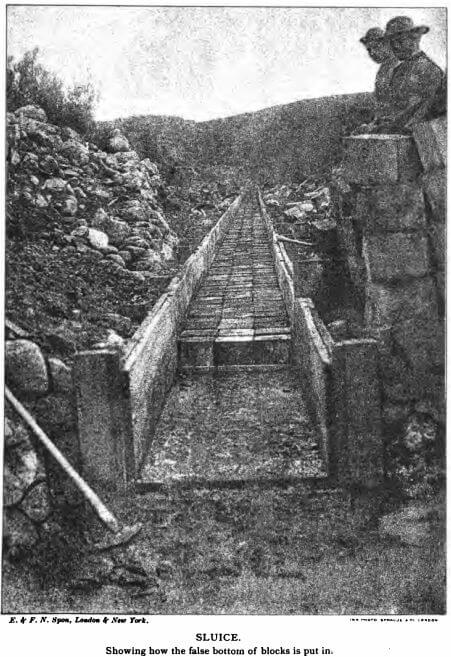
Grade
The grade of the sluice is an all-important consideration, and depends on the gravel bank— generally there will be found distinct layers of gravel, interspersed with pipe-clay and sandstone; and evidently deposited at distant intervals of time.
The top of the bank will probably be covered with vegetation; beneath which the gravel will probably be very fine, and containing but little gold. This may be succeeded by larger gravels, in varying strata, alternating with sandstone, stiff red clay or hard conglomerate, in very distinct layers, the latter requiring (unless the water power be very large) gunpowder or dynamite to break it down.
A safe grade to adopt (unless the boulders are very large and the gravel very free) is one in thirty-three(1’/33′). This is sufficiently rapid to allow the gravel to travel down the sluice, get thoroughly washed and disintegrated, and so set free the tiny particles of gold mechanically mixed with it. In the case of large boulders occurring, it is necessary to remove them from the sluice by specially constructed “forks,” or if too large to handle, by “ derricks.” All obstructions—roots, timber, &c.—must be removed, to prevent choking the sluice; as any overflow from a blocking of the waterway would lose gold.
Having determined the best point of attack, the ditch must be brought as near as possible, so as to avoid an expensive outlay on “ piping,” and the bulkhead must be erected.
Ditch
A ditch 6 feet wide at the top, 3 feet at the bottom, and 3 feet 6 inches deep, will carry some 2500 to 3000 “ miner’s inches ” of water, according to the rapidity of its grade.
Miner’s inch of water
A miner’s inch of water is the quantity which will pass in 24 hours through an aperture of a square inch under a pressure of 6 inches, and is equal to 2190 cubic feet, or 12,960 gallons of water, or about 58 tons weight.
Bulkhead
The bulkhead should be constructed, 10 feet by 5 feet by 10 feet high, of two thicknesses of 1½-inch plank, with joints to overlap. The frames of 9-inch by 9-inch rough timber cut on the spot.
The flume from the ditch enters the bulkhead at the top. A screen across the centre prevents stones, bits of wood, &c., from passing into the pipe, and so endangering the safety of the “ monitor.” An overflow also at the top allows the surplus water to escape. A manhole at the bottom of one of the sides enables the sand and dirt to be cleaned out when necessary.
Sluice
The bottom of the sluice should be of five planks, 1½ inch thick by 11 inches wide; the sides of two planks, 1½ inch by 11 inches wide. The joints should fit perfectly true; and if slightly open, the open part should not be on the top thus, as gold and mercury would drop in and not be easily got out, but the planks should join tight at the top thus, and any imperfection in the joint be underneath.
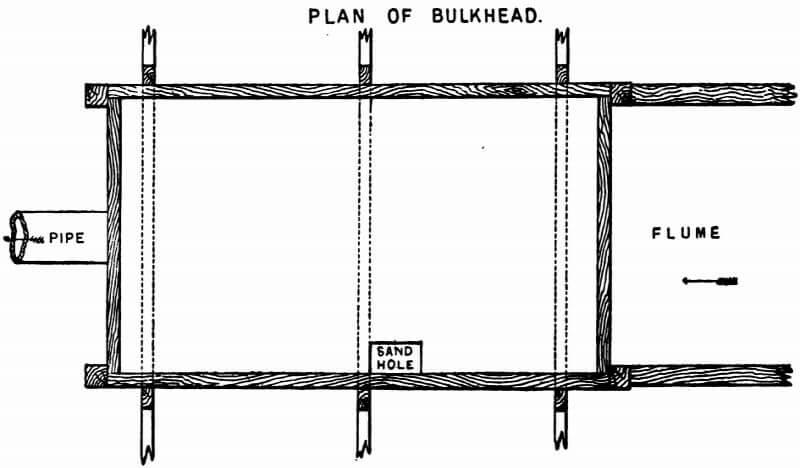
The frames should be of 6-inch by 4-inch timber, and the sluice should be lined on each side by two 11-inch by 1½-inch planks, nailed to the sluice, to protect it; and the lower edge of this lining should be 1½ inch above the bottom of the sluice. This enables the “riffle-strips,” which separate the blocks forming the false bottom, to be laid in and taken out easily.
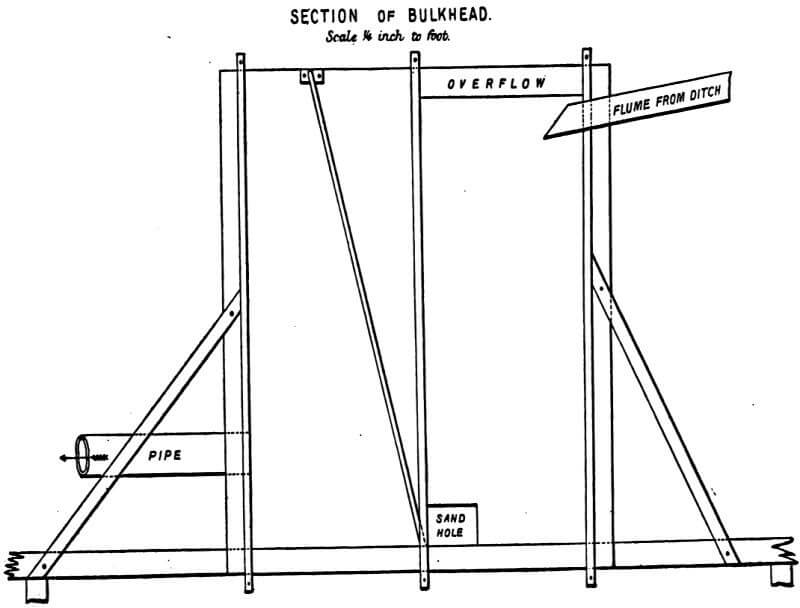
Riffles
There are numerous methods of making the false or “ riffle-bottoms ” for the sluices; but, as timber and saws are always available, I prefer as the best all-round method (and which is not beaten by any other, and can always be easily renewed when worn), blocks 10½ inches square and 8 inches deep, placed in the bottom of the sluice, and separated by strips of wood laid across the bottom of the sluice, of a section of 1½ inch by 1½ inch. These should not be nailed; but a small wedge of wood will keep them from shifting, and they can be removed with ease without damaging the woodwork of the sluice; as in the case if nailed down and tom up on the occasion of each “ clean up.”
If there is no pipeclay intermixed in the gravel bank, and the stuff disintegrates very easily and sets free the gold rapidly, a steeper grade, say 1 in 24, may be used in constructing the sluice; but it seldom happens that pipeclay is absent, and in that case it would travel down the sluice without being sufficiently broken up to set free the gold, and would, moreover, from its natural adhesiveness, pick up any gold it might come in contact with, and hurry it through the sluice and out on the dump, where it would be lost, if too steep a grade were employed.
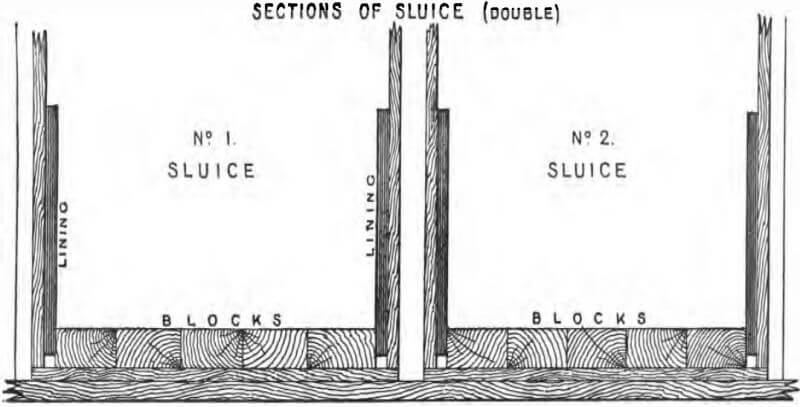
For economical working it is better to make two parallel sluices, so that when one is being cleaned up the other may be working, as a great saving of time is thus effected.
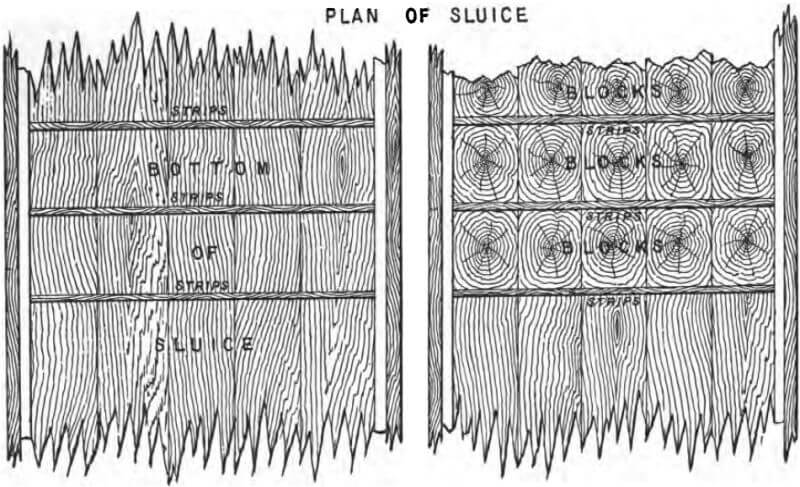
Pipe
The main pipe from the bulkhead may be 2 feet or more in diameter as it leaves the bulkhead, and reduced to 18 inches in the first 100 feet. It should be fitted with two vacuum valves; as, in the event of one of the monitors “ blowing off,” the pipe would collapse from the sudden vacuum formed, were it not for the valves. The 18-inch pipe should continue down to the distributor, from which the water will be conducted to the two monitors by two pipes of 15 inches diameter.
Hydraulic Mining Monitors
The two monitors of No. 5 size are fitted with deflectors, and each with four nozzles, of 5 inches, 6 inches, 7 inches, 8 inches diameter, according to the quantity and pressure of the water supply, and it is often in dry seasons well to have a smaller size even than 5 inches, say 2 inches or 3 inches, so that the man in charge may at any moment fit on that which is most suitable for the water supply offering at the moment.
The double sluice (if two are constructed) should, when within, say, 300 feet of the gravel bank, open out into two single sluices; and the monitors should be placed in the fork of the two sluices, to work on either side.
Messrs. Eraser and Chalmers, of Chicago, supply excellent monitors, and they can also be obtained in Glasgow, through Messrs. Duncan Bros., Engineers, of Westminster, or Mr. George Green, of the Foundry, Aberystwith.
Arrangements should be made to have rapid communication with the man in charge at the canal dam or pipe-head reservoir; so that in case of an accident at the mine, such as the blowing off of a nozzle or the bursting of a pipe, the water may be immediately shut off and the supply to the bulkhead stopped.
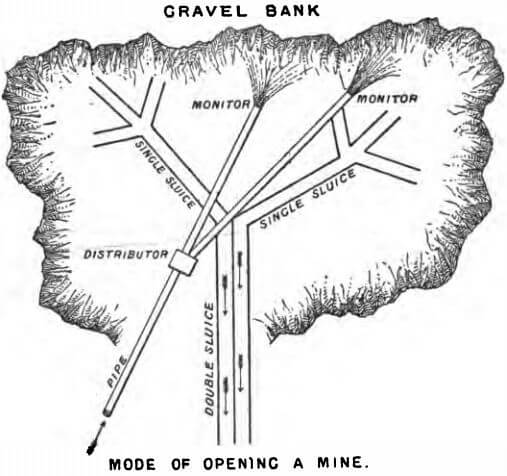
The monitor is capable of being moved to the right or left, or elevated or depressed, by an ingenious arrangement of sockets requiring no exertion on the part of the man directing it; and it is counterbalanced by a box filled with stones to compensate for the weight and pressure of the water.
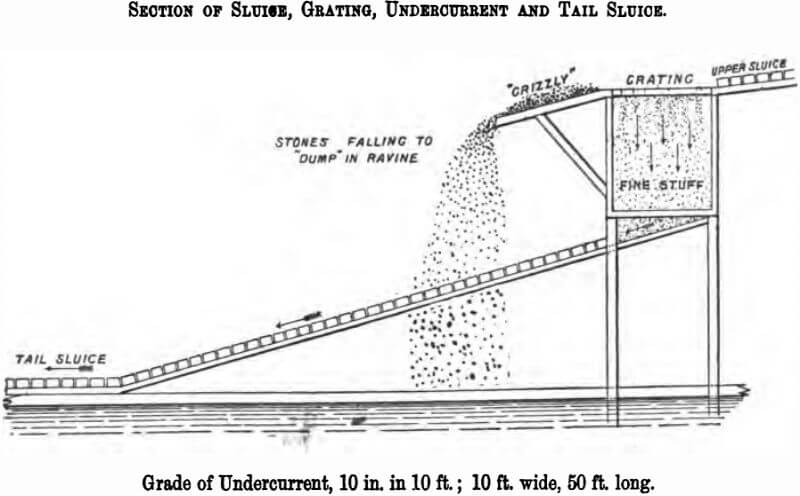
Undercurrent
At the lower end of the sluice a grating of fire bars, parallel to the course of the sluice, with half-inch interstices between them, enables the water and fine particles to fall through the sluice, while the larger gravel travels on from the impetus it has acquired, and is precipitated in any direction desired to the waste dump or ravine.
Bars
The bars for the undercurrent should be 5 feet long, 6 inches wide and 1¾ inch thick, and should be cast with the thin end upwards, so that any “ blow-holes ” from imperfect casting should be underneath when the bars are in position, while the upper surface will be harder, more perfect and more durable.
The “ smalls ” fall with the water on to a sloping channel which takes them to the undercurrent, the force and direction of the muddy mass being controlled by a number of lozenge-shaped pieces of wood fixed on a pivot which can be turned by the overlooker, so as to spread the current evenly over the undercurrent.
The length and width of the undercurrent depend on the facilities of the locality. A good arrangement is one of 12 feet wide and 50 feet long; the bottom is blocked exactly as in the sluice, but the section of the strips may be reduced to 1 inch. The worn sluice blocks from the main sluice work in very Economically for the undercurrent, as owing to the light matter passing over them in this place there is very little wear and tear.
The water and mud from the tail of the undercurrent, if it is considered to be “ free of gold ” and not worth putting over a second undercurrent, can be utilised by diverting it to assist the passage of the large stones into the ravine.
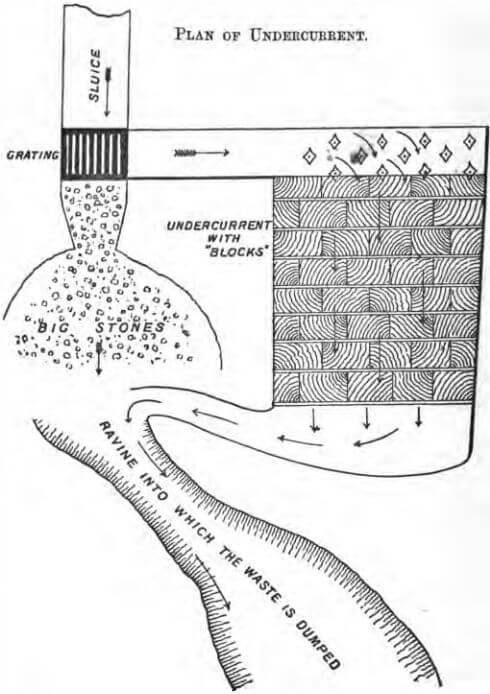
Grade
The grade of the undercurrent should be much steeper than that of the main sluice; and not, as has been popularly described in some works (whose authors can have had no practical acquaintance with the subject), a less steep grade; for the result of one built on such principles, however much it may at first sight commend itself, will in practice be found to be absolutely useless, and will result in the settling of the fine sand and slimes on the blocks, and the entire disappearance of the undercurrent within 48 hours!
Experience on the spot will decide, from the character of the smalls, what grade to adopt. It may vary from 18 inches to 8 inches in 12 feet (that is, from 1 inch in 18 inches to 1 inch in 8 inches).
Tailings
The overlooker must carefully examine the tailings to see that no gold is being carried off, and must either alter the grade or lengthen the undercurrent to meet the circumstances.
He should also keep an eye on what is passing over the grating, as it is always possible that nuggets too large to pass between the openings of the grating may be contained in the gravel, which would of course be lost if permitted to fall over into the dump. Their specific gravity will cause them to travel much slower than the gravel, and an experienced eye would at once detect and rescue them.
Bed-rock
It will be obvious from the above that the importance of laying the sluice on “ bed-rock ” cannot be over-estimated.
Whether the bed-rock on which the gravel deposit reposes be slate or granite, is immaterial in regard to this cardinal question.
To break down the bank of gravel and then permit the washed material to travel over a gravel bottom before reaching the end of the sluice, would be to allow the gold to hide itself in the gravel and be lost; while, if it passes over granite, the smooth nature of the rock assists its progress to the sluice; and if over slate, the natural rugosity of that formation detains it in its crevices and it is easily seen and removed.
The proper point at which the gravel bank should be attacked having been ascertained by a careful survey, and, if necessary, by the driving of trial adits to discover if possible the centre of the old river channel (which will contain the richest gold in the deposit), the bulkhead and pipes, together with the monitors, having been completed, and the sluice constructed, the water should be turned on and allowed to flow through the sluice for a day or two, carrying with it any poor gravel that can be conveniently played upon, so that the wood of the sluice should swell and fit tight, and any interstices existing should be filled up before commencing serious operations.
The Run
When all is ready, the full power of the water is directed at the base of the bank, and, according to the yielding property of the gravel, the whole superposed mass will fall on to the bed-rock in the course of a few hours. The water is then directed on the fallen mass, and the muddy torrent is guided by the workmen to the mouth of the sluice.
This operation continues without intermission, night and day, for 20 or 30 days, until the manager judges that he has a sufficient amount of gold collected in the sluice to make it worth while to “ clean up.”
After the first two days’ running, he will have poured into the upper 150 feet of the sluice, five or six bottles of mercury, say 400 lbs. weight.
The fine particles of gold dissolve in the mercury, which lodges in the interstices between the blocks ; of course the warmer the temperature the more rapid is the action of the mercury in seizing the gold, as when water approaches the freezing-point mercury becomes very sluggish—but as it can find its way through infinitesimally small apertures, the importance of making the sluices as closely fitted as the finest cabinet work becomes apparent; and the great importance of clearing away any obstructions which may occur in the channel of the sluice will exercise the vigilance of the manager.
Clean up
The period for the clean up having arrived, the supply of water from the ditch is diminished to a quantity which will cover the bottom of the sluice to a depth of 3 or 4 inches, and it is allowed to run clean for an hour or two before the work of taking up the blocks is commenced.
Each series of blocks, commencing at the head of the sluice, is then removed, together with the dividing strips; and each block is carefully washed in the sluice before stacking at the side.
The manager then enters the sluice, and takes up, in a scoop of a special form, the mercury, which shows as the fine gravel is rolled down by the clear water. Each time that he takes up the mercury, and the gravel which comes up with it, he presents the mouth of the scoop to the current, and by a dexterous turn of the wrist, he ” vans out ” the gravel, leaving only the mercury in the scoop. He must carefully examine any gravel which remains towards the end of the vanning operation, to see if, as its weight and reluctance to leave the scoop would indicate, it has any gold mechanically attached to or encrusted in it. Having picked these pieces out, he pours the mercury into a small iron bucket, fitted with a tripod stand sufficiently high to keep it well above the water in the sluice, and recommences. This operation is continued until he has picked up all the mercury in the sluice, and may occupy five or six hours.
The buckets, with the mercury contained, are carried to the counting house as they are filled. The blocks and strips are then replaced in the sluice, any necessary repairs or alterations in the structure are completed, any additional lengths required to advance the sluice in the direction of the receding bank are fixed, and the operation of washing for another “ run ” is recommenced.
In case the sluice has been made a double one, the operation of the monitor is continuous, and much time lost in cleaning up is economised.
At many mines the whole length of the sluice, together with the undercurrent, is only cleaned up once in three months. Only the upper 300 or 400 feet is each month taken up; by which means the “ crop-ore ” is removed monthly, and an accumulation of the finer ore in the lower portion of the sluice swells the amount of the three-monthly return.
Instead of parallel sluices, a branch sluice brought in to join the main sluice some few hundred feet down from its head, is often a convenient arrangement; but details such as these must be left to the judgment of the manager on the spot.
The collected mercury is easily washed clean from the small remaining amount of gravel floating on it, and is then squeezed through chamois leather or very close woven linen, by which means the golden amalgam is retained as a hard mass in the leather or cloth, while the unsaturated mercury escapes through the fine orifices and is returned to the bottles.
The amalgam will be found in practice to contain from 30 to 36 per cent, of its weight in gold.
Retorting
The mass is then placed in the retort. The furnace heat drives off the mercury, which is condensed by wet cloths, or a water-jacket, placed round the tube, and the mercury drops into a bucket of water. Care must be taken that the nose of the tube does not enter the water, or a vacuum would be created in the retort and an explosion would follow.
When all the mercury has been driven off and the retort cooled, the mass of gold is taken out and melted in a plumbago crucible with a small amount of borax, or preferably neutral borate of soda, to free it from any impurities. It is then poured into the ingot moulds, and, when cool, weighed and despatched to its destination.
It will be seen from the above account that the whole process of collection of the gold is exceedingly simple, economical, and requiring no scientific knowledge, good judgment in the laying out of the ditch and sluice being the main factor in successful hydraulic mining, coupled with vigilant attention to the continuous operation.
Night Lighting
With the large water supply at the mine, it is easy to erect the necessary plant for electric lighting at night; and this will be found an outlay that will soon repay itself.
Dump
It is scarcely necessary to draw attention to such an evidently important factor in the success of the mine as the dump or receptacle for the waste washed gravels. As a large mine washes from 2000 tons per day, upwards, the ground must be chosen for the tail of the sluice where millions of tons can be got rid of without blocking up the outlet. A ravine of great depth, or a rapid and storm-washed river bed, which does not interfere with ” vested interests,” should always be preferred.
Ditch Building
For the construction of the ditch the following will be found a very close estimate, the labour being calculated at sixpence per hour for good labour:
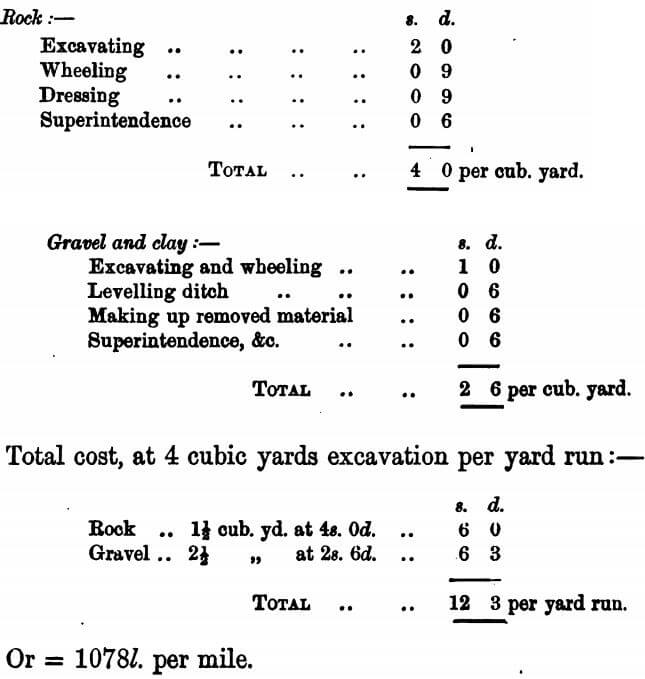
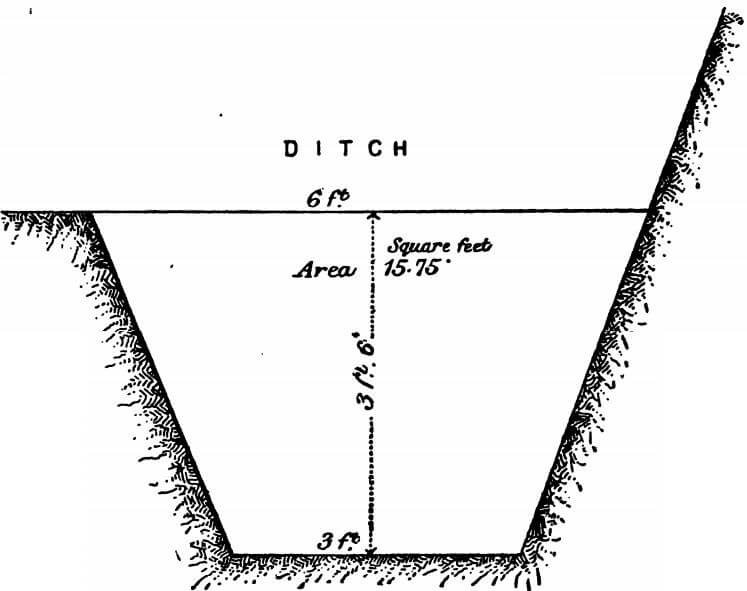
Pro Forma Specification of Stores Required for Opening an Hydraulic Mine
10 cwt. 7/8-inch borer steel.
1 dozen steel mallets for boring, 7 lbs.
12 hand-saw files.
3 tenon-saw files.
15 6-inch pit-saw files.
15 8-inch cross-cut saw files.
3 smith’s sledge-hammers, 9 lbs.
1 cwt. cast steel for steeling picks.
1 dozen riveting hammers.
1 dozen set tools for ¼-inch rivets.
1 dozen snap tools.
6 hand-hammers, Nos. 10 and 12 tester heads.
10 dozen miner’s steel shovels, diamond points.
5 dozen Cornish picks.
10 dozen handles for ditto.
1 dozen long Colonial pattern felling axes.
2 small portable forges.
1 best black staple smith’s vice.
2 anvils (farrier’s pattern) 150 lbs. each.
2 grindstones 27 inches diam. (1 coarse, 1 fine).
2 sets screw stocks, dies, taps, and wrenches complete, from 7/16-inch to ¾-inch and 7/8-inch to 1¼- inch, engineer’s.
3 expanding spanners.
20 cwt. best cut nails 2½ inches.
10 cwt. best cut nails 3½ inches.
16 cwt. best cut nails 4 inches.
4 cwt. best cut nails 4½ inches.
4 cwt. best cut nails 5 inches.
4 cwt. spikes, 7 inches.
4 cwt. spikes, 9 inches.
1 dozen riveting blocks.
2 dozen pairs of tools for riveting pipes.
500 lugs for ditto.
4 sets carpenters’ bench planes (jack, trying and smoothing).
4 3-inch bench screws and nuts.
6 4-lb. carpenter’s axes, with handles.
2 sets socket mortise chisels, with handles.
3 pair 12-inch wing compasses.
6 2-foot rules to fold 12 inches.
2 2-foot rules to fold 6 inches.
4 carpenter’s set stones.
2 pair pincers.
2 2-foot iron squares, graduated inches.
4 14-inch carpenter’s plated squares.
4 6-inch carpenter’s plated squares.
4 dozen carpenter’s pencils.
3 spirit levels, set in straight edge, 30 inches long, with handle on top to protect level.
6 hand-saws (7 teeth to inch).
4 fine ditto, for cross cutting.
4 carpenter’s table saws.
3 12-inch tenon saws.

4 carpenter’s marking mortises.
4 hand-saw sets.
6 pit-saw sets.
6 14-inch drawing knives.
3 plated spokeshaves.
6 12-inch turnscrews.
2 ploughs and irons.
6 adzes (12-inch handles).
6 ½-inch screw augers.
6 ¾-inch augers.
6 7/8-inch augers.
6 1 1/8-inch augers.
3 1¼-inch augers.
3 1½-inch augers.
3 2-inch augers.
3 dozen caulking irons, single crease.
4 plated angle bevils.
2 joiner’s cramps, 6 feet long.
60 feet of 1¼-inch bar iron.
130 lbs. soft iron wire, No. 12 B.W.G.
1 cwt. white lead.
16 door locks (different).
2 dozen padlocks.
5 dozen 4-inch butt hinges.
2 gross 1½-inch screws.
1 gross 1-inch screws.
7 gross smaller (for locks).
10 pieces of unbleached calico (for making tight joints in pipe).
2 dozen ordinary iron buckets.
2 dozen black iron scoops.
1 dozen hard brushes.
20 bottles mercury.
2 No. 5 “ monitors,” with deflectors and nozzles, as described in text.
2 18-inch vacuum valves.
2500 feet 18-inch diameter pipe, No. 14 B.W.G., ¼-inch rivets.
500 feet 15-inch diameter pipe, No. 14 B.W.G., |-inch rivets.
100 feet 30-inch diameter, tapering to 18 inch, No. 14 B.W.G., and ¼-inch rivets.
2400 feet run of 11-inch by 3-inch timber, cut into 11-inch by 1½-inch, in 20-22-feet lengths, second St. Petersburg deals.
4000 feet run 6-inch by 4-inch in 12-22-feet lengths, third St. Petersburg deals.
1 small distributor.
Melting pots, ingot moulds.
Chemicals—borax, carbonate of potassa and soda, &c.
Tongs, cobbing hammers, and iron plates.
Blankets, cold chisels, scales and weights.
Red lead, litharge.
The cost of the above will be under £2000.
The Following Notes Will be Found Useful for Reference
A miner’s inch of water should move from 2 tons to 2½ tons of gravel per day of 24 hours.
A gallon of water weighs (roughly) 10 lbs.
A cubic foot of water weighs (roughly) 60 lbs.
One horse-power (1.H.P.) raises 150 lbs. 220 feet high in a minute for 8 hours daily, and can draw 4480 lbs. (= 2 tons) horizontally, and is equal to 7 men.
5 men working 10 hours = 1 horse working 8 hours.
For computing work, 14 cubic feet of granite may be taken to represent 1 ton.
A centner = 114 lbs.
A litre = 1¾ imperial pints.
A kilogramme = 2 lbs. 8 ozs. 4½ dwt. avoirdupois.
A gramme = 1 cubic centigramme,and weighs 15.434 grains troy.
A kilometre = 5 furlongs.
Charcoal and coke produce about equal amounts of heat; but, owing to the greater bulk occupied by charcoal, coke produces most heat in a given time.
Eau regale, the only acid which dissolves gold, is one volume of nitric mixed with three volumes of hydrochloric acid (more or less).
All metallic nitrates are soluble in water.
The chlorides of silver and mercury are the only metallic chlorides insoluble in water.
Chloride of lead is nearly insoluble in neutral brine, but very soluble in acidulated brine.
Most metallic sulphates are soluble in water, excepting those of lead, strontium and baryta. Alkaline carbonates are the only carbonates soluble in water, and are the only ones undecomposable by heat alone, but all carbonates are decomposable by heat with the addition of carbon. Alkaline silicates, with a great excess of base, are the only silicates soluble in water.
All rocks not calcareous are silicious.
The melting point of gold is about 2000° Fahrenheit, or 1100 Centigrade.
Formula to convert a degree of Fahrenheit to Centigrade, and vice versa:—
5 (F – 32)/9 = Centigrade. 9 C/5 + 32 = Fahrenheit
To find the specific gravity of a stone:—
Divide the weight in air by the loss of weight in water of the temperature of 60° Fahr. The quotient is the specific gravity.
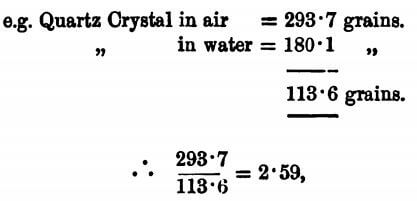
which is the specific gravity of quartz.
An excellent fire lute is made of 8 parts of sharp sand, 2 parts of good clay, 1 part horse-dung; mix, and temper like mortar.
An English sovereign weighs 123.274 grains, and contains of pure gold 113 grains.
An English shilling weighs 87.27 grains, and contains of pure silver 80.727 grains.
For approximate calculations—
A grain of gold may be taken as 2d.
A dwt. of gold may be taken as 4s.
A dwt. of gold in a cwt of ore = 1 oz. of gold per ton of ore.
Assaying
To assay gold quartz—
take 200 grains ore.
500 grains litharge.
6 grains lampblack.
500 grains carbonate of soda.
Or, another way—
200 grains ore.
200 grains red lead.
150 grains carbonate of soda,
8 grains charcoal,
6 grains borax.
Mix and put into warmed crucible, and cover with half an inch of common salt; fuse in a hot fire 30 minutes; cool, and break the pot; clean the button with a small hammer.
If the quartz is very pyritous— take 1000 grains and calcine “dead” without clotting.
Add 500 grains red lead.
35 grains charcoal.
400 grains borax.
400 grains carbonate of soda.
Cover with salt and proceed as above.
In each case cupel the button.
As the bone ash of which the cupel is made can absorb its own weight of metallic oxides, the cupel chosen should always exceed the weight of the button to be operated on, so as to have a margin. Boil the gold prill obtained from cupelling in nitric acid, which dissolves the silver and leaves the gold pure.
The above formulae are open to modification by the operator according to the apparent richness or poverty of the ore to be treated, and the presence and character of the basic impurities. In case there are oxides, a reducing agent is required; and if sulphides, an oxidising agent.
As a rule employ a weight of litharge twice that of the ore, and of carbonate of soda the same as the ore. These reagents are added to control the size of the lead button, and to obtain one of a suitable size for cupelling.
Mercury
Great attention should be paid to the condition of the mercury before putting it into the sluice. As purchased it is seldom pure, and in that case is unable to seize the gold.
Mercury absorbs oxygen from the air, which forms with it a very slight covering over the metal, but quite sufficient to prevent its combination with gold, as there is no actual contact of the two metals. This pellicule can be removed by pouring out the mercury, and passing a large and very dry glass tube over its surface. Turning the tube gently the oxide skin adheres to the glass, and is easily removed. Moreover, the mercury of commerce is seldom free from metallic impurities, and mere redistillation does not get rid of these. If the mercury, after distillation, be put back into its iron bottle, and nitric acid, mixed with double its volume of water, be added, and the whole heated to say 150 degrees Fahrenheit, a certain amount of nitrate of mercury is formed, and this, together with the free acid present, reacts on and dissolves the foreign metals, as well as any small amount of oxide of mercury which has been formed by the contact of air during distillation. Leave the acid in the bottle for 24 hours, shaking it well from time to time. Then drive off the water by gently heating the bottle. A crust of nitrate of mercury will cover the surface. (This is easily removed, and the metallic mercury can be recovered from it.) The mercury should then be thoroughly washed with clean water. This operation is well worth doing, and repealing, till the purity of the mercury is ascertained beyond all doubt; as thousands of pounds are lost through the impurity of the mercury purchased for mines.
If there be no metallic impurities present, but merely oxidisation from contact with air, pour the mercury into glass bottles and add a little concentrated sulphuric acid (SO3).
Shake the bottles till the mercury is broken up into small globules, so that it can all come in contact with the acid. This will remedy the trouble. After two or three days, pour off the acid and thoroughly wash the mercury with repeated fresh waters.
The purity of the mercury employed cannot be too much insisted on, or too carefully watched, and is probably one of the points least considered and most neglected—while it is emphatically all-important.
